
Ambystoma macrodactylum
(Long-toed Salamander)
Key Characteristics:
|
Adult Characteristics |
Larval Characteristics |
Egg Characterisitcs |
|
Extra long 3th |
Long feathery |
Pigmented |
|
Solid or broken dorsal stripe |
9-12 gill rakers |
Singly or clusters up to 100 |
|
Lack parotoid glands |
Balancers present on early larvae |
Attached or loose |
|
Costal grooves |
. |
Cluster usually linear |
|
Tubercules |
. | . |
General Description:
These small salamanders (up to 85mm) have a dark ground color (dark brown to black) with a dorsal stripe running from nose to tail. This dorsal stripe may have uneven edges or may even be broken into blotches. The color of the dorsal stripe varies from shades of yellow to green. Long-toed Salamanders have bluish flecks on their sides, and their ventral coloration is generally grayish.
The characteristic that is the namesake for this species is the extra long 3th toe on the hind feet. The specific epithet also describes this trait, it translates as "large digit (toe)".
The costal grooves of Long-toed Salamanders are readily apparent and the general body form resembles that of the Tiger Salamander (albeit more petite). Long-toed Salamanders can be distinguished from the Coeur d'Alene Salamander (Family: Plethodontidae) by the absence of both nasolabial grooves and the absence of a pale patch under the chin.
The larvae of Long-toed Salamanders can be distinguished by their uniform dorsal coloration and their long feathery external gills (with 9-12 gill rakers ). During their early development, Long-toed Salamanders have dermal projections on each side of their head. These projections are called balancers and may aid the larvae in keeping their balance and preventing them from sinking to the muddy bottom (Pough, 1998).
Long-toed Salamanders have pigmented eggs that are approximately 2.5mm in diameter. These eggs can be laid singularly or in clutches up to 100. The eggs can either be attached to submerged vegetation and debris or they can be loose on the substrate.
Idaho Distribution:
In Idaho, Long-toed Salamanders are more widespread than any other salamander species. They are found throughout northern and down into central Idaho.
Habitat:
From shrub steppe to alpine meadows (up to 3050 m), in variety of habitats including dry woodlands, humid forests, and rocky shores of mountain lakes.
Long-toed Salamanders are generally found in moist areas in a variety of habitats ranging from desert brush, open forests, developed areas and high mountain meadows. During the breeding season, they can be found in or near ponds, vernal pools or small lakes.
Diet:
Larvae feed on zooplankton, immature insects, snails, and (occasionally) other salamander larvae. Adults eat terrestrial and aquatic invertebrates, including insects, insect larvae, spiders, slugs, earthworms, and amphipods.
Ecology:
Hibernates/aestivates. Adults are subterranean, except during breeding season. Predators of larvae probably include aquatic insects and garter snakes; garter snakes and bullfrogs eat adults.
Reproduction:
In Idaho, elevation affects breeding season and clutch size. Populations below 2100 m breed in spring; those above 2100 m breed in midsummer. Clutch size is larger at lower elevations. Larvae metamorphose in first summer or, at high elevations, overwinter.
Conservation:
|
Status: |
Unprotected nongame species |
|
Global Rank: |
G5 |
|
State Rank: |
S5 |
Important State References:
Howard, J.H. and R.L. Wallace. 1985. Life history characteristics of populations of the long-toed salamander (Ambystoma macrodactylum) from different altitudes. Amer. Midl. Nat. 113: 361-373.
Original images provided by Charles R. Peterson, ©1997
Species description, key characteristics and original html by John Cossel Jr.© 1997.
Species ecological information from Groves et al.© 1997.
Updated design, image optimization and final revision by Ean Harker ©1999, 2000.
Adaptation for DAI by Stephen Burton and Mike Legler 1999.
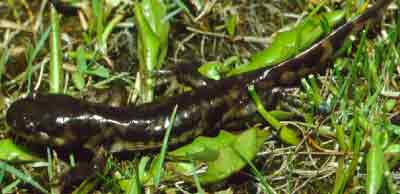
Ambystoma tigrinum
(Tiger Salamander)
Key Characteristics:
|
Adult Characteristics |
Larval Characteristics |
Egg Characterisitcs |
|
Large |
Long feathery |
Pigmented |
|
Small |
More than 16 gill |
Single or clusters |
|
Lack parotoid glands |
Lack balancers |
Usually attached |
|
Costal grooves |
. |
Cluster usually |
General Description:
These heavy-bodied salamanders are the largest representatives of the family Ambystomatidae (up to around 13 inches total length). They are variably colored, ranging from black, tan or olive ground color and olive, yellow or tan markings (some have almost no markings at all). The blotches generally form a marbled pattern. Tiger Salamanders have evident costal grooves along their sides, and their eyes seem to protrude from their large head.
The larvae of this species are adapted for pond habitats and consequently have certain larval characteristics such as long delicate external gills and a wider fin along their tail. Tiger Salamander larvae can be distinguished from larvae of Long-toed Salamander and Rough Skinned Newts because they have more than 16 gill rakers on the third gill arch. Tiger Salamander larvae also lack balancers (these are two small growths from the sides of the head in young larvae).
The eggs of this species are about 2.5mm across and are laid in linear clumps ranging from a single egg to 120 eggs. Tiger Salamander eggs are pigmented brown dorsally (Nussbaum et al. 1983) and are generally attached to submerged plants or debris.
Idaho Distribution:
In Idaho, Tiger Salamanders can be found in suitable habitat in the eastern part of the state, the western edge of the panhandle and in some southwestern areas.
Habitat:
Found in virtually any habitat, providing there is nearby body of water suitable for breeding. In Idaho, suspected to be present in scattered populations throughout appropriate habitat of grasslands and shrub steppe.
Tiger Salamanders are generally found in ponds, small lakes or slow moving streams in grassy or sagebrush cover. These secretive salamanders are not often encountered as they are largely fossorial. They are sometimes found out in the open on moist evenings following rains. The aquatic larvae can be abundant in ponds or wetlands with limited aquatic vegetation (Stephen Burton, unpubl. data).
Feeding:
Adults eat any small animal that can be captured and swallowed. Larvae eat aquatic invertebrates and vertebrates (especially amphibian larvae) as available.
Ecology:
Hibernates/aestivates. Activity is often associated with rainfall. Inactive in winter in colder climates. Terrestrial adults are usually underground in self-made burrows, or in those made by rodent or other animals. In some years, drying of breeding pond may result in total reproductive failure.
Reproduction:
Lays up to 1000 eggs, singly or in small clusters, on submerged vegetation. Larvae metamorphose in first or second summer, or become paedomorphic. In Idaho, breeding occurs in spring.
Conservation:
|
Status: |
Unprotected nongame species |
|
Global Rank: |
G5 |
|
State Rank: |
S5 |
Original images provided by Charles R. Peterson, ©1997
Species description, key characteristics and original html by John Cossel Jr.© 1997.
Species ecological information from Groves et al.© 1997.
Updated design, image optimization and final revision by Ean Harker ©1999, 2000.
Adaptation for DAI by Stephen Burton and Mike Legler 1999.
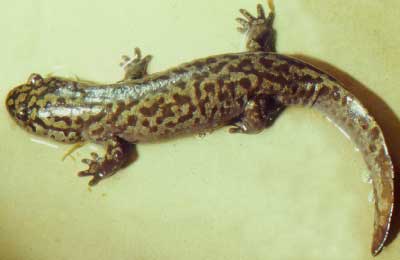
Dicamptodon aterrimus
(Idaho Giant Salamander)
Key Characteristics:
|
Adult Characteristics |
Larval Characteristics |
Egg Characteristics |
|
Inconspicuous |
Small gills (adapted to streams) |
Unpigmented eggs |
|
Robust body |
Yellowish patches |
Attached singularly |
|
Marbled pattern |
. | . |
General Description:
As the name suggests, the Idaho Giant Salamander is the largest salamander found in the state of Idaho. These salamanders have robust bodies and heads and can grow to lengths of 33cm total length. Idaho Giant Salamanders have a dark marbled pattern of spots or blotches on a brown, gray, tan or copper ground color. Unlike the Tiger Salamander, which it superficially resembles, the Idaho Giant Salamander lacks the readily visible costal grooves. Another characteristic of these salamanders is that the fourth toe on the hind foot only has three segments (Stebbins 1985).
The larvae of this salamander are adapted to living in streams, as shown by their short, small gills. Other distinguishing characteristics of these larvae are yellowish blotches on a tan ground color. Some individual larvae of this species can become sexually mature while maintaining the larval form, this is called paedomorphosis.
Idaho Giant Salamander eggs are unpigmented and attached singularly under submerged logs and rocks. The 6.5mm diameter eggs may be laid in groups of 135-200
Idaho Distribution:
In Idaho, these salamanders are restricted to the north-central forested areas.
Habitat:
Larvae usually inhabit clear, cold streams, but are also found in mountain lakes and ponds. Adults are found under rocks and logs in humid forests, near mountain streams, or on rocky shores of mountain lakes.
Idaho Giant Salamanders are generally found in moist coniferous forests. The transformed adults are secretive and seldom found in the open, but can be found in moist areas such as under logs and bark. They need a water source for reproduction. Often, this is a the headwaters of a mountain stream, a spring or mountain lake. Idaho Giant Salamander larvae are more frequently encountered and may be locally common. They and are usually found under rocks in mountain streams.
Diet:
Larvae feed on wide variety of aquatic invertebrates as well as some small vertebrates (e.g., fishes, tadpoles, or other larval salamanders). Adults eat terrestrial invertebrates, small snakes, shrews, mice, and salamanders.
Ecology:
Hibernates/aestivates. Usually reaches sexual maturity (in both larval and terrestrial forms) at sizes greater than 115 mm (snout to vent length).
Reproduction:
Breeding occurs in spring and fall. Female lays clutch of 135-200 eggs in spring, and guards eggs until hatched. Life history is variable and complex. At some sites, all larvae metamorphose and reproduce as terrestrial adults. At other locales, high percentage of individuals are paedomorphic.
Conservation:
|
Status: |
Unprotected nongame species |
|
Global Rank: |
G3 |
|
State Rank: |
S3 |
Important State References:
Cassirer, E.F. 1995. Wildlife inventory, Craig Mountain, Idaho. Idaho Dept. Fish & Game, Lewiston. 182 pp.
Original images provided by Charles R. Peterson and Edmund D. Brodie, Jr., ©1997
Species description, key characteristics and original html by John Cossel Jr.© 1997.
Species ecological information from Groves et al.© 1997.
Updated design, image optimization and final revision by Ean Harker ©1999, 2000.
Adaptation for DAI by Stephen Burton and Mike Legler 1999.
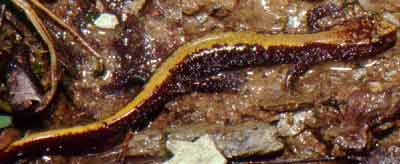
Plethodon idahoensis
(Coeur d'Alene Salamander)
Key Characteristics:
|
Adult Characteristics |
Larval Characteristics |
Egg Characterisitcs |
|
Nasolabial groove |
No free-living larval stage |
Terrestrial |
|
Yellow patch on throat |
. |
Grape-like cluster |
|
Parotoid glands |
. |
Attached via single thread |
|
Parasphenoid teeth |
. |
Unpigmented |
General Description:
Coeur d' Alene Salamanders are small, slender salamanders attaining lengths of around 100mm (4 in.). They have a grayish-black ground color with light colored speckles. The dorsal stripe has uneven edges and is a yellow or gold color. The ventral coloration is also dark with the exception of a yellow patch on the throat. This helps distinguish it from the Long-toed Salamander, which lacks this patch. Other features of this species that aid in distinguishing it from Long-toed Salamanders are the slender body form, short toes and nasolabial grooves.
The larvae of this species develop within the egg and consequently there are no free-living forms. The eggs are small, unpigmented, and are laid in a grape-like cluster. The egg cluster is attached to the underside of a rock or log via a single thread.
Idaho Distribution:
In Idaho the Coeur d'Alene Salamander is found in the northern part of the state.
Habitat:
Found in 3 major types of habitat: springs or seepages; spray zones of waterfalls; and edges of streams. Often associated with fractured rock formations.
These salamanders are generally found in moist talus, seeps and splash zones, which may be situated in open forests, meadows or riparian areas. Couer d'Alene Salamander eggs are deposited terrestrially, and can be found in similar habitat under rocks or logs.
Diet:
Feeds on aquatic insects.
Ecology:
In northern Idaho, emerges from winter hibernation in late March and is active near surface through April and May. Retreats underground to aestivate (except near seepages and waterfalls) from June to mid-September, becomes active again with September through early November rains, then hibernates until March. Surface activity is negatively correlated with high daytime temperature and number of days since last rain.
Reproduction:
Mating occurs in late summer and fall, and occasionally in spring. Females store sperm up to 9 months before fertilizing eggs. Average of 6 eggs are laid in April-May. Young emerge from underground in September. Individuals first breed in fourth and fifth years. In Idaho, females have biennial reproductive cycles.
Conservation:
|
Status: |
Unprotected nongame species |
|
Global Rank: |
G3 |
|
State Rank: |
S3 |
Important State References:
Cassirer, E.F., C.R. Groves, and D. Genter.1993. Sensitive species management guide for the Coeur d’Alene salamander. Idaho Dept. Fish & Game, Boise, and the Montana Natural Heritage Program, Helena. 38pp.
Original images provided by Charles R. Peterson and William Leonard, ©1997
Species description, key characteristics and original html by John Cossel Jr.© 1997.
Species ecological information from Groves et al.© 1997.
Updated design, image optimization and final revision by Ean Harker ©1999, 2000.
Adaptation for DAI by Stephen Burton and Mike Legler 1999.
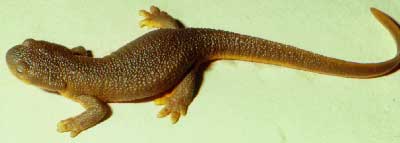
Taricha granulosa
(Rough-skinned Newt)
Key Characteristics:
| Adult Characteristics | Larval Characteristics | Egg Characteristics |
|
Costal grooves absent |
No maxillary teeth |
Pigmented |
|
Rough granular skin |
Fewer than 8 gill rakers |
Attached singularly |
|
Solid dark brown |
Eyes along margin of head |
|
|
Yellow to reddish- |
Yellowish tan with |
|
|
Balancers in early |
General Description:
The Rough-Skinned Newt is rare in Idaho and was probably introduced. They have only been found in a few ponds near Moscow, Idaho. Consequently, most of the information about this species comes from populations occurring in Washington and Oregon. They are easily recognized by their rough granular skin and the absence of costal grooves. Rough-Skinned Newts have a dark brown to tan color dorsally and a yellow to orangish-red color ventrally. Males of this species can attain a size of around 170mm total length while the smaller females average around 140mm total length.
The larvae of Rough-Skinned Newts have the generalized "pond type" body (larger gills and tail fin extending above hind legs). They can be identified by the absence of maxillary teeth and their coloration, which consists of a yellowish-green dorsal color with spots, and a pinkish to salmon ventral color. Finally, the eyes of these larvae don't extend past the margin of the head.
Rough-Skinned Newts lay their pigmented eggs singularly and generally attach them to submerged vegetation or debris. Mating and egg laying take place in ponds, lakes and slow moving streams (this is not known for Idaho).
Idaho Distribution:
Rough-Skinned Newts are rare in Idaho and have only been found in several ponds near Moscow, Idaho. It is believed that they may have been introduced to these ponds.
Distribution was not modeled for this species.
Habitat:
Rough-Skinned Newts are generally found in forested areas, but can also occur in grassy valleys and even agricultural areas. These salamanders are somewhat unique in that they can sometimes be found on the surface in broad daylight. They secrete a very toxic substance from their skin, and it is suggested that this is what affords their non-secretive habits. The larvae are found in ponds, lakes and slow moving streams and adult forms can often be found in these aquatic habitats as well. The adults however, are not restricted to aquatic environments and can be found quite a distance from water. Generally, these terrestrial adults are found under logs, bark, etc. but as was mentioned above they can also be seen out in the open.
Diet:
No information currently available.
Ecology:
No information currently available.
Reproduction:
No information currently available.
Conservation:
|
Status: |
Unprotected nongame species | |
|
Global Rank: |
G3 |
|
|
State Rank: |
S? non-native species | |
Original images provided by Charles R. Peterson and William Leonard, ©1997
Species description, key characteristics and original html by John Cossel Jr.© 1997.
Species ecological information from Groves et al.© 1997.
Updated design, image optimization and final revision by Ean Harker ©1999, 2000.
Adaptation for DAI by Stephen Burton and Mike Legler 1999.
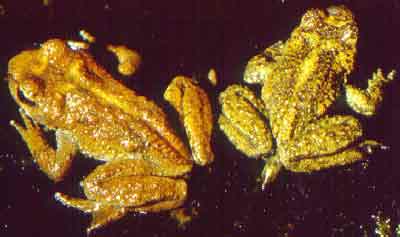
Ascaphus truei
(Tailed Frog)
Key Characteristics:
| Adult Characteristics | Tadpole Characteristics | Egg Characteristics |
|
Lack a tympanum |
Sucker-like mouth |
Non-pigmented eggs |
|
Wide fifth toe |
White spot |
Attached to bottom of stones in streams |
|
Males have averted |
. | . |
|
Males don't call |
. | . |
|
Pupil is vertical |
. | . |
General Description:
These small frogs usually attain sizes of around 40-50mm (2 in.), and are variably colored ranging from brown, reddish-brown, green, or gray, with some degree of mottling. A dark eye line is often present (Nussbaum et al. 1983). Perhaps the most obvious feature is the "tail" on males, which is actually an intermittent organ used to transfer sperm to females. The fifth toes on the hind feet are wider than the other toes. Tailed Frogs lack tympanic membranes, and it's believed that they don't have a mating call. Their pupils vertical.
Tailed Frog tadpoles are unique in that they have a sucker-like mouth. This helps them attach to rocks, which allows them to maintain their position in the swift mountain streams where they live.
The eggs of Tailed Frogs are found attached to the bottom of stones in streams and they are unpigmented. The eggs are around 4-5mm (0.2 in.) in diameter.
Idaho Distribution:
Tailed Frogs are distributed throughout the central and north central forests of Idaho where suitable habitat is found.
Habitat:
Found from sea level to over 2000 m, in clear, cold, swift-moving mountain streams. May be found on land during wet weather, near water in humid forests, or in more open habitat. Stays on moist streambanks during dry weather.
Tailed Frogs are found in permanent, cool mountain streams or under stream side debris. The adults can forage up to 25m from stream in wet conditions; although this is generally at night (Nussbaum et al. 1983). The larvae are generally found attached to smooth rocks in streams.
Diet:
Larvae feed mostly on diatoms. Adults eat wide variety of insects and other invertebrates.
Reproduction:
Breeds from May through October (late August and September in Idaho). Fertilization is internal; male has tail-like copulatory organ. Clutch size averages 44-75 eggs, which are laid in July, and hatch from August through September. Larval period lasts 2-4 yr in mountains and northern areas, and 1 yr in a few coastal Oregon populations. Inland populations metamorphose after 3 yr; metamorphosis starts in July and ends in September. Adults may not breed until 7-8 yrs old, or 6-8 yrs after metamorphosis.
Conservation:
|
Status: |
Unprotected nongame species |
|
Global Rank: |
G4 |
|
State Rank: |
S3 |
Important State References:
Cassirer, E.F. 1995. Wildlife inventory, Craig Mountain, Idaho. Idaho Dept. Fish & Game, Lewiston. 182 pp.
Species description, key characteristics and original work by John Cossel Jr. © 1997
Species ecological information from Groves et al. ©1997.
Original images provided by Charles R. Peterson and Charlotte C. Corkran,© 1997
Design and Optimization by Ean Harker©1999, 2000.
DAI layout by Stephen Burton, and Mike Legler © 1999.
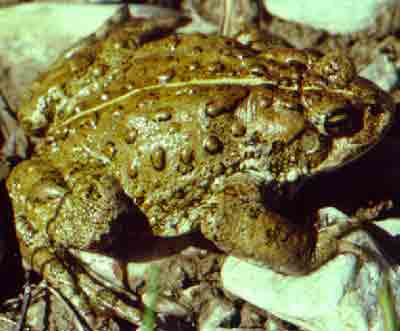
Bufo boreas
(Western Toad)
Key Characteristics:
|
Adult Characteristics |
Tadpole Characteristics |
Egg Characteristics |
|
Oval parotoid glands |
Dark colored |
Long 2 stranded string |
|
Horizontal pupil |
Tadpoles usually gregarious |
Double gel layer |
|
Light vertebral stripe |
Eyes don't extend |
Darkly pigmented |
|
2 horny tubercles |
. | . |
|
Bumpy skin |
. | . |
|
Squat body with |
. | . |
|
Males call |
. | . |
General Description:
Western Toads are roughly the same size as Woodhouse's Toads, ranging from 55 to 125mm (up to 5inches). They are also similar in that the females are generally larger than the males. Western Toads can be light tan, gray, greenish or brown in dorsal coloration. They have a light colored (white or cream) vertebral stripe running down their back. Ventrally, Western Toads usually have dark blotches or mottling, on a light cream ground color. Western Toads lack cranial crests and have oval shaped parotoid glands that aren't overly elongated (not more than twice as long as they are wide). Other identifying characteristics are the lack of teeth in the upper jaw, a horizontal pupil and the presence of two tubercles on each of their hind feet.
Western Toad tadpoles attain lengths up to around 25mm (1 in.) and are usually very dark in coloration. Their eyes are inset (when viewed from above). Often, Western Toad tadpoles are found swimming in large aggregations along the shallows of ponds and lakes.
Western Toad eggs are laid in a double-stranded string that may extend up to several meters in length. The eggs are darkly pigmented and have two gel layers (this helps distinguish them from Woodhouse's Toad eggs, which have a single gel layer).
Idaho Distribution:
Western Toads are widely distributed in Idaho and can be found in appropriate habitat throughout most of the state.
Habitat:
Western Toads are largely terrestrial but can generally be found within a fair proximity to water. Their habitats range from mountain meadows to brushy desert flats.
Diet:
In Northwest, larvae filter suspended plant material, or feed on bottom detritus. Adults eat all types of flying insects and spiders, crayfish, sowbugs, and earthworms.
Ecology:
Digs burrow in loose soil or uses burrows of small mammals. Activity varies seasonally and geographically. At low elevations, individuals are mainly diurnal in late winter and spring, and nocturnal in summer. Mountain populations are active day or night in summer, depending on conditions. Hibernation occurs in winter in cold climates. Birds and garter snakes prey on adults, and predatory insect larvae feed on young. Western toads appear to be declining in Greater Yellowstone Ecosystem and in other parts of western United States.
Reproduction:
Breeding period varies according to conditions, but usually occurs from late January through July (in Snake River Canyon, breeding occurs in early July as an adaptation to high levels of runoff water). Females deposit an average of 12,000 eggs/clutch; eggs are laid in 2 strands. Larvae metamorphose in second summer in mountains, and in first summer in other areas. Males do not have a mating call as do many frogs and other toads, but they do vocalize and can be heard.
Conservation:
|
Status: |
Protected nongame species |
|
Global Rank: |
G4 |
|
State Rank: |
S4 |
Important State Reference:
Bartelt, P.E. and C.R. Peterson. 1994. Riparian habitat utilization by western toads (Bufo boreas) and spotted frogs (Rana pretiosa). Final report to the USDA Forest Service Inter. Res. Sta., Boise. 30pp.
Species description, key characteristics and original work by John Cossel Jr. © 1997
Species ecological information from Groves et al. ©1997.
Original images provided by Charles R. Peterson, Edward Koch and Charlotte C. Corkran,© 1997
Design and Optimization by Ean Harker©1999, 2000.
DAI layout by Stephen Burton, and Mike Legler © 1999.
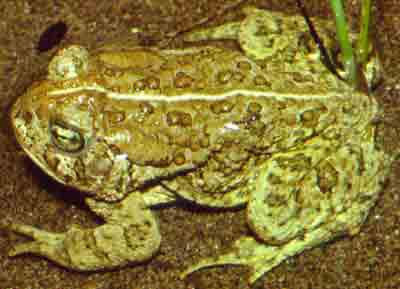
Bufo woodhousii
(Woodhouse's Toad)
Key Characteristics:
|
Adult Characteristics |
Tadpole Characteristics |
Egg Characteristics |
|
Cranial crests |
Dark colored |
Long two |
|
Long oval shaped parotoid glands |
Tail dark above, |
Single gel layer |
|
Light vertebral stripe |
Eyes don't extend to margin of head |
Darkly pigmented |
|
Horizontal pupil |
Round body with a jutting snout |
. |
|
Two tubercles on |
. | . |
|
Males call |
. | . |
General Description:
Woodhouse's Toads are fair sized anurans reaching sizes up to125mm (5 in.) for females and around 100mm (4 in.) for males. The color varies from light gray to brown dorsally. The ground color is generally marked with contrasting spots. The spots are generally located on the "warts" or bumps containing the poison glands. The ventral coloration is usually a light yellow to cream with dusky flecks on the throat and chest. These toads can easily be identified by the cranial crests found on the top of the head. The two ridges form what has been described as "back to back Ls". The parotoid glands also distinguish this toad from the other Bufo species found in Idaho. Woodhouse's Toads have long oval shaped parotoid glands (Western Toads have shorter more rounded parotoid glands). Woodhouse's Toads have two horny tubercles on each hind foot. During the breeding season males will call from breeding sites to attract females. The call has been likened to a bleating lamb or a "waaaaah".
Woodhouse's Toad tadpoles generally have a dark overall coloring with mottling and the tail is lighter ventrally. The eyes on these tadpoles don't reach the margin of the head (they are inset). These tadpoles can attain a size around 25mm (1 in.). Tadpoles of Woodhouse's Toads can be difficult to distinguish from Western Toad tadpoles.
Woodhouse's Toad eggs are laid in a double-stranded string that is characteristic of many toads. The eggs are 1 to 1.5mm in diameter and can be distinguished from Western Toad eggs by the presence of a single gel layer (Western Toad eggs have 2).
Idaho Distribution:
This species is found throughout most of U.S., portions of northern Mexico, and northern shore of Lake Erie in Canada. Absent from parts of New England and Florida, from high mountains of West, and from West Coast.
Woodhouse's Toads are restricted to the western portion of Idaho, particularly along the Snake River and its associated drainages.
Habitat:
Found in grasslands, shrub steppe, woods, river valleys, floodplains, and agricultural lands, usually in areas with deep, friable soils.
Woodhouse's Toads are typically found in habitats such as prairies, agricultural areas and brushy flats often associated with a water source. The water source may vary from irrigation ditches, ponds, small lakes to backwaters of the Snake River. Even though there is generally water in the area, they may forage quite a distance from the water source that they mate and lay eggs in.
Diet:
Metamorphosed toads eat various small, terrestrial arthropods. Larvae eat suspended matter, organic debris, algae, and plant tissue.
Ecology:
Mostly nocturnal, but diurnal activity is not uncommon. Active in wet or dry weather. Inactive during cold months of fall, winter, and early spring. When inactive, burrows underground, or hides under rocks, plants, or other cover.
Reproduction:
Breeding choruses may last a few weeks. Female lays clutch of up to 25,000 eggs in spring or summer (depending on geography), usually after heavy rains. Larvae metamorphose in 1-2 mo (by end of July in some locations), and in some areas reach sexual maturity in 2 yr.
Conservation:
|
Status: |
Unprotected nongame species |
|
Global Rank: |
G5 |
|
State Rank: |
S3 |
Species description, key characteristics and original work by John Cossel Jr. © 1997
Species ecological information from Groves et al. ©1997.
Original images provided by Charles R. Peterson and Charlotte C. Corkran,© 1997
Design and Optimization by Ean Harker©1999, 2000.
DAI layout by Stephen Burton, and Mike Legler © 1999.

Scaphiopus intermontanus
(Great Basin Spadefoot Toad)
Key Characteristics:
|
Adult Characteristics |
Tadpole Characteristics |
Egg Characteristics |
|
Vertical pupils |
Dark colored with gold specks |
Eggs in small (grape to plum-sized) clusters |
|
"Spade" on |
Extremely rapid development |
Attached to |
|
Smoother skin |
Prominent nostrils |
. |
|
Lack parotoid glands |
Anteriorly positioned mouth |
. |
|
Slightly upturned nose |
Keratinized beak |
. |
|
Males call |
. | . |
General Description:
Great Basin Spadefoot Toads are small anurans reaching a size of around 65mm (2.5 in.). Males are slightly smaller than females. They are variable in color, generally having a ground color of tan, gray or olive. The ground color is usually broken by two lighter colored stripes running down either side of the back, and there may also be spots which are sometimes a reddish-orange color. The ventral color is generally a white or light cream. The black "spade" on each of the hind feet is an easily recognizable characteristic. Other characteristics of the adults include the slightly upturned nose, a bump between the eyes and fairly smooth skin. Great Basin Spadefoot Toads can be differentiated from the other two toad species in Idaho by the absence of parotid glands and the presence of vertical pupils (the other toad species have horizontal pupils). Adults can be found out on moist evenings calling from suitable breeding areas. The males have a call described as a grating "wah" that is given in short repetitive calls.
The egg masses laid by these anurans are small (grape or plum-sized) clumps of pigmented eggs that are generally attached to submerged vegetation or debris. The eggs themselves are around 1mm in diameter and as an adaptation to xeric environments, they develop and hatch very quickly.
The tadpoles of Great Basin Spadefoot Toads are fairly large (up to 70 mm or 2.8 in.) and heavy bodied. The tadpoles are a pale tan color with golden-metallic specks. The nostrils are dorsally located and prominent. The anteriorly-located mouth has a keratinized beak.
Idaho Distribution:
Great Basin Spadefoot Toads are distributed throughout the deserts, prairies of southern Idaho.
From extreme southern British Columbia, through Great Basin to extreme northwestern Arizona, and from edge of Cascade-Sierra axis east to Rockies.
Habitat:
Great Basin Spadefoot Toads are typically found in arid or semiarid regions. These anurans are usually associated with open habitats such as desert brush and grasslands. Great Basin Spadefoot Toads are adapted to burrowing and may stay buried for many months. The habitats they occupy must have water available at least every few years. The body of water can be in the form of irrigation ponds, rain pools or other shallow lakes and ponds. Some breeding sites may be in harsh temporal wetlands such as mudflats.
Found from sea level to about 2800 m, on shrub steppe, pinyon/juniper woodlands, and spruce/fir forests, but is restricted to shrub steppe habitats in the Northwest. Uses variety of temporary and permanent waters for breeding.
Diet:
Not well known over entire range. Larvae probably eat algae, organic debris, and plant tissue. Adults are known to eat ants, beetles, grasshoppers, crickets, and flies.
Ecology:
Hibernates/aestivates. Primarily nocturnal, but sometimes forages during day. Digs burrow in loose soil, or uses burrows of small mammals to escape heat and dry periods. Predators include birds and probably fishes. Adult spadefoots have noxious skin secretions known to repel predators and cause sneezing in humans.
Reproduction:
Breeding occurs sporadically from April through July, often after spring or summer rains (in the Northwest, breeding season is irregular in response to local moisture conditions). Female lays eggs in small packets of 20-40; total eggs may equal 300-500. Under optimal conditions, eggs probably hatch in about 2-3 days. Larval period lasts a few to several weeks.
Conservation:
|
Status: |
Unprotected nongame species |
|
Global Rank: |
G5 |
|
State Rank: |
S4 |
Species description, key characteristics and original work by John Cossel Jr. © 1997
Species ecological information from Groves et al. ©1997.
Original images provided by Charlotte Corkran and Jonathon M. Beck © 1997
Design and Optimization by Ean Harker©1999, 2000.
DAI layout by Stephen Burton, and Mike Legler © 1999.
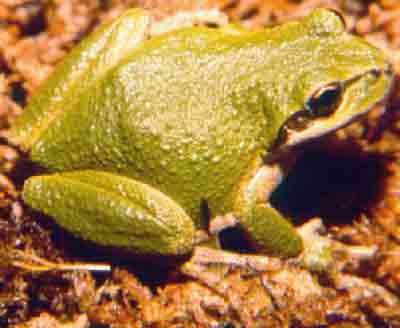
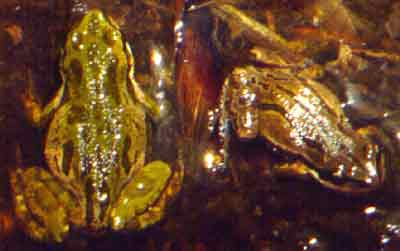
Pseudacris maculata
(Boreal Chorus Frog)
also: Pseudacris triseriata maculata
Key Characteristics:
|
Adult Characteristics |
Tadpole Characteristics |
Egg Characteristics |
|
Pointed snout |
Brown dorsally and |
Small clusters |
|
Long toes with |
Eyes extend past |
Pigmented |
|
Three stripes (sometimes broken) |
Intestines visible |
. |
|
Limited webbing |
Dorsal fin more arched than in Pacific Treefrog |
. |
|
Males call |
. | . |
General Description:
Boreal Chorus Frogs are small anurans reaching lengths of up to around 38mm (1.5 in.). The ground color of these frogs varies from shades of brown, gray or green. Boreal Chorus Frog dorsal coloration usually includes three dark stripes (these may be broken). Boreal Chorus Frogs have a dark eye stripe similar to that of the Pacific Treefrog, but it extends to the groin area (Pacific Treefrog eyestripes end above the shoulder). They may have a dark triangle pattern on their head. The ventral coloration is yellowish, cream or white and there may be dark markings on the throat and chest. Boreal Chorus Frogs have long toes with small toe pads and limited webbing between the toes (Pacific Treefrogs have more pronounced toe pads). Male Boreal Chorus Frogs will call during the breeding season, making a loud chirping sound. The call is short in duration, and they may repeat it 30 to 70 times per minute.
In the Pacific Northwest, Boreal Chorus Frog tadpoles can be distinguished as Hylidae tadpoles by the fact that the eyes are on the margin of the head rather than being inset. Boreal Chorus Frog tadpoles are brown dorsally, have a white ventral coloration and their intestines are visible. The tadpoles reach a size of around 30mm (1.2 in.) before metamorphosing. Boreal Chorus Frog tadpoles are difficult to distinguish from Pacific Treefrog tadpoles, with the main difference being the more highly arched dorsal fin in Boreal Chorus Frog tadpoles (Nussbaum et al. 1983).
The eggs of Boreal Chorus Frogs are small, around 1 mm (1/25th in.) in diameter. They are pigmented and are often hard to find. They are laid in clusters of 30 to 75 and are generally attached to submerged vegetation or debris.
Idaho Distribution:
In Idaho, the Boreal Chorus Frog can be found in the eastern portion of the state, and along the Snake River Plain to the western border of the state.
South-central Canada and most of U.S. east of Rocky Mountains. Absent from most of southeastern Coastal Plain, New England, and northern Appalachians.
The model greatly under predicts the distribution on the map.
Habitat:
Found in moist habitats near breeding ponds, ditches, and marshes; found above 2000 m in Idaho.
Boreal Chorus Frogs are typically found in marshy vegetated areas. During the breeding season, they are usually associated with a water source such as irrigation ditches, marshes, ponds and lakes. The water source is often vegetated, providing both cover and attachment sites for their eggs. At times other than the breeding season, they can be found in grassy or moist vegetated areas.
Diet:
Metamorphosed frogs eat various small terrestrial arthropods. Larvae eat suspended matter, organic debris, algae, and plant tissue.
Ecology:
Hibernates/aestivates. Inactive in winter in northern range. Active day and night when breeding. Generally diurnal in cooler months of spring and fall, more crepuscular and nocturnal in hot weather. When inactive, hides in water, thick vegetation, under objects on ground, or in rodent burrows. Local populations may include a few dozen adults or as many as tens of thousands of individuals. Garter snakes and tiger salamander larvae prey on tadpoles.
Reproduction:
Congregations of singing males initiate breeding season with loud distinctive calls. Females fasten packets of eggs to vegetation. Aquatic larvae metamorphose in spring or summer, and become sexually mature in first, second, or third year. In Idaho, adults breed between March and June, depending on elevation and latitude.
Conservation:
|
Status: |
Unprotected nongame species |
|
Global Rank: |
G5 |
|
State Rank: |
S4 |
Important State Reference:
Clark, R.J., C.R. Peterson, and P. E. Bartelt. 1993. The distribution, relative abundance, and habitat associations of amphibians on the Targhee National Forest. Final report to the Targhee National Forest, St. Anthony. 16pp.
Species description, key characteristics and original work by John Cossel Jr. © 1997
Species ecological information from Groves et al. ©1997.
Original images provided by Charles R. Peterson, Edward Koch and Charlotte C. Corkran,© 1997
Design and Optimization by Ean Harker©1999, 2000.
DAI layout by Stephen Burton, and Mike Legler © 1999.

Rana catesbeiana
(Bullfrog)
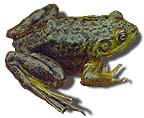
Key Characteristics:
|
Adult Characteristics |
Tadpole Characteristics |
Egg Characteristics |
|
Large tympanum |
Eyes inset from |
Pigmented |
|
Lack dorsolateral ridge |
Olive ground color |
Large sheets |
|
Have a dorsal fold |
Dorsal fin doesn't |
. |
|
Large size |
. | . |
|
Males call |
. | . |
General Description:
Bullfrogs are the largest anurans occurring in Idaho. They may reach sizes between 150mm to 200mm (7.9 in.) snout-to-vent length. They are easy to recognize due to the presence of a fold of skin that extends from the eye, goes around the large tympanum![]() and down to the shoulder. Bullfrogs lack the dorsolateral folds present on Northern Leopard Frogs. Bullfrogs vary in color, but generally have a dorsal ground color that is some shade of green with darker spots or blotches. Their ventral coloration is white to yellowish and may have dark mottling to some degree. Male Bullfrogs give a deep bass call while defending their territory and attempting to attract females.
and down to the shoulder. Bullfrogs lack the dorsolateral folds present on Northern Leopard Frogs. Bullfrogs vary in color, but generally have a dorsal ground color that is some shade of green with darker spots or blotches. Their ventral coloration is white to yellowish and may have dark mottling to some degree. Male Bullfrogs give a deep bass call while defending their territory and attempting to attract females.
Bullfrog tadpoles are equally large (compared to other tadpole species), and may reach lengths of up to 150mm (6 in.). Their dorsal coloration is generally an olive to yellowish green with numerous black specks. Their ventral coloration ranges from white to cream. Their dorsal fin doesn't extend onto the body and their eyes are inset from the margin of their head (unlike the Hylid tadpoles). Bullfrog tadpoles overwinter and don't metamorphose until late the following summer.
Bullfrog eggs are laid in large sheets, over 300mm (12 in.) in diameter. The eggs are initially laid on the surface but they sink to the underlying vegetation and debris before hatching. The small eggs (1.3mm or 1/20 in.) are pigmented and generally hatch in 4 or 5 days. Even though the eggs themselves are small, large clutches of up to 20,000 eggs may be laid.
Idaho Distribution:
In Idaho the distribution of Bullfrogs is associated with the Snake River Plain in the western portion of the state and in the western part of the panhandle.
Distribution was not modeled for this species.
Habitat:
Since its introduction into the Pacific Northwest, the Bullfrog has become well established in many permanent waters, especially at lower elevations. These frogs are highly aquatic and are seldom found far from the edge of their water source. Permanent water sources such as lakes, ponds, sloughs, slow moving rivers and streams are all utilized by Bullfrogs.
Conservation:
|
Status:
|
Game species | |
|
Global Rank:
|
G5
|
|
|
State Rank:
|
SE nonnative species to Idaho | |
Species description, key characteristics and original work by John Cossel Jr. © 1997
Species ecological information from Groves et al. ©1997.
Original images provided by Charles R. Peterson, Henry J. Fabian and Charlotte C. Corkran,© 1997
Design and Optimization by Ean Harker©1999, 2000.
DAI layout by Stephen Burton, and Mike Legler © 1999.
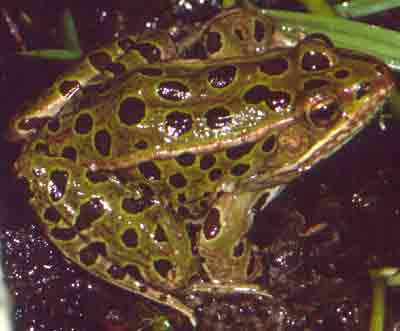
Rana pipiens
(Northern Leopard Frog)
Key Characteristics:
|
Adult Characteristics |
Tadpole Characteristics |
Egg Characteristics |
|
Prominent |
Brown with |
Pigmented |
|
Dark blotches |
Eyes set in from |
Flattened spherical clusters |
|
White ventral |
Intestines visible |
. |
|
Males call |
Tail fin translucent |
. |
General Description:
Northern Leopard Frogs are medium sized reaching sizes up to 100mm (4 in.). They are easily recognized by the dark spots that are surrounded by light colored halos. Their ground color is usually some shade of green or brown. Northern Leopard Frogs have a white ventral coloration. Additional distinguishing characteristics are the prominent dorsolateral ridges found running from behind the eye to the groin and the readily visible tympanum. Males will congregate and produce a chorus described as a guttural chuckling. The males will actually produce three distinct calls with varying sounds (see Nussbaum et al. 1983).
Northern Leopard Frog tadpoles are similar, although smaller, than Bullfrog tadpoles, reaching sizes of around 85mm (3.3 in.). Northern Leopard Frogs tadpoles lack the black specks of Bullfrog tadpoles, having metallic flecks on a brown dorsal color instead. Ventrally, Northern Leopard Frog tadpoles are translucent with the intestines readily visible.
Northern Leopard Frog eggs are small (1.5mm or 1/25 in.) in diameter and are laid in flattened spherical clusters. Each clutch can contain up to 6,000 eggs. Multiple females may lay clutches in the same area as evidenced by the photo.
Idaho Distribution:
In Idaho, Northern Leopard Frogs are found throughout much of the southern part of the state, following the Snake River Plain. Populations also exist in the northern portion of the panhandle.
From Great Slave Lake and Hudson Bay, Canada, south to Kentucky and New Mexico. Introduced in number of localities in western states.
Habitat:
Northern Leopard Frogs are generally associated with heavily vegetated marshes, ponds, streams etc. Likewise, they seem to breed in areas that are also heavily vegetated. In Idaho, they may be found in or around ponds, lakes and marshes
Diet:
Metamorphosed frogs eat various small invertebrates obtained along water's edge or in nearby meadows or fields. Adults rarely eat small vertebrates, although in Idaho, northern leopard frogs are known to eat birds, garter snakes, tadpoles, small frogs, and fishes, as well as snails, leeches, spiders and small insects. Larvae eat algae, plant tissue, organic debris, and probably some small invertebrates.
Ecology:
Probably hibernates in streams, ponds or other aquatic locations in winter. Disperses to moist uplands or permanent water during dry-up in summer. Requires moderately high ground cover for concealment. Preyed upon by garter snakes. When disturbed, these frogs leap rapidly and erratically. Anecdotal information exists for their decline in Idaho.
Reproduction:
Lays clutch of up to several thousand eggs from March to June, depending on range (in Idaho, breeding activity begins in March or April, when water temperatures reach 10° C). Aquatic larvae usually metamorphose in summer, but may overwinter in some areas. In most areas, adults reach sexual maturity in 2 yr.
Conservation:
|
Status: |
Unprotected nongame species |
|
Global Rank: |
G5 |
|
State Rank: |
S3 |
Important State Reference:
Groves, C.R. and C. Peterson. 1992. Distribution and population trends of Idaho amphibians as determined by mail questionnaire. Idaho Dept. Fish & Game, Boise. 16pp.
Species description, key characteristics and original work by John Cossel Jr. © 1997
Species ecological information from Groves et al. ©1997.
Original images provided by Charles R. Peterson, Alan St. John, Michael McDonald, Edward Koch and Charlotte C. Corkran,© 1997
Design and Optimization by Ean Harker©1999, 2000.
DAI layout by Stephen Burton, and Mike Legler © 1999.
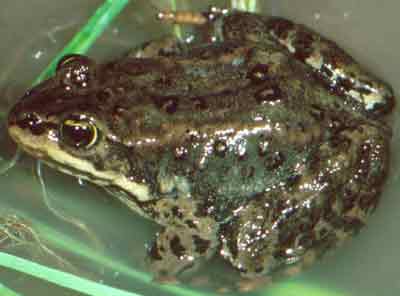
Rana luteiventris
(Columbia Spotted Frog)
Formerly: Rana pretiosa
Key Characteristics:
|
Adult Characteristics |
Tadpole Characteristics |
Egg Characteristics |
|
Light colored stripe |
Eyes very inset |
Pigmented |
|
Narrow pointed snout |
Intestines visible |
Spherical clusters |
|
Upturned eyes |
Brownish- |
Eggs float |
|
pink or yellow ventrally |
. | . |
|
Webbing extends |
. | . |
|
Males call |
. | . |
General Description:
The Columbia Spotted Frog is a medium-sized frog reaching sizes of up to 90mm (3.5 in.) in length. Their dorsal ground color ranges from olive green to brown and is marked by spots having irregular borders and light-colored centers. The ventral ground color is a light cream or white but the abdomen and legs are a brightly colored salmon color or yellow (young frogs lack this coloration). A final characteristic dealing with color is the light-colored stripe that runs along the upper lip. Morphological characteristics that distinguish the Columbia Spotted Frog are the narrow snout and the upturned eyes. The eyes appear to be mostly uncovered by the eyelid when viewed from above. They have shorter hind legs than Northern Leopard Frogs of comparable size. The structure of their feet hints at their aquatic lifestyle since the webbing extends nearly to the tip of the longest toe. During the breeding season, males will congregate at suitable breeding sites and call. The call has been described as a series of 6-9 low (soft and hard to hear) "clucks".
Columbia Spotted Frog tadpoles are generally brownish-green dorsally with gold flecks. Ventrally these tadpoles have a silvery color and their intestines are visible. Columbia Spotted Frogs have inset and upturned eyes. They reach a size of around 80mm (3.1 in.) before metamorphosing.
The egg masses of Columbia Spotted Frogs are generally easy to find and recognize. The eggs are laid in small spheres that may include up to 1300 eggs. The egg masses absorb water and become softball-sized spherical masses that float to the surface (Charles R. Peterson pers. com.). The individual eggs are 2.3mm or 1/10 in. in diameter and are pigmented. The egg masses are usually laid in the shallows of a permanent water source. They are not attached to vegetation and float freely in the water. Several females may lay their clutch in the same area and the same site may be reused in subsequent years.
Idaho Distribution:
In Idaho, Columbia Spotted Frogs can be found in appropriate habitat throughout much of the northern part of the state. There are also some isolated populations in southwestern Idaho.
From extreme southeastern Alaska, south through western Alberta to coastal Oregon and Washington, and east to northern Wyoming, northern Utah, and central Nevada.
Habitat:
Columbia Spotted Frogs are fairly aquatic and are generally found in or near permanent bodies of water such as lakes, ponds, sluggish streams and marshes. The littoral zone is generally comprised of emergent vegetation including grasses and sedges. During the summer these frogs can be found some distance from the breeding sites but still associated with moist vegetation.
Found from sea level to about 3000 m, usually in hilly areas near cool, permanent, quiet water in streams, rivers, lakes, pools, springs, and marshes. Highly aquatic, but may disperse into forests, grasslands, and brushlands. In the Northwest, prefers areas with thick algae and emergent vegetation, but may use sunken, dead, or decaying vegetation as escape cover.
Diet:
Opportunistic. Eats wide variety of insects as well as different mollusks, crustaceans, and arachnids. Larvae eat algae, organic debris, plant tissue, and minute water-borne organisms.
Ecology:
Hibernates/aestivates, depending on range. Inactive in winter in north. May move overland in spring and summer after breeding. Species is thought to be declining in parts of range, but appears widespread and abundant in Idaho. Bullfrogs are predators.
Reproduction:
Breeds: February at sea level in British Columbia; mid-March at 1395 m in Utah; and from May through June at 2377 m in Wyoming. Wyoming study found that females breed yearly at low elevations, and every 2-3 yr at high elevations. Females may lay egg masses in communal clusters. Males may require 4 yr (females 6 yr) to reach maturity.
Conservation:
|
Status: |
Unprotected nongame species |
|
Global Rank: |
G4 |
|
State Rank: |
S4 |
Important State References:
Munger, J.C., L. Heberger, D. Logan, W. Peterson, L. Mealey, and M. Caughlin. 1994. A survey of the herpetofauna of the Bruneau Resource Area, Boise District, with focus on the spotted frog (Rana pretiosa). Idaho Bur. Land Manage. Tech. Bull. 94-7.
Species description, key characteristics and original work by John Cossel Jr. © 1997
Species ecological information from Groves et al. ©1997.
Original images provided by Charles R. Peterson © 1997
Design and Optimization by Ean Harker©1999, 2000.
DAI layout by Stephen Burton, and Mike Legler © 1999.
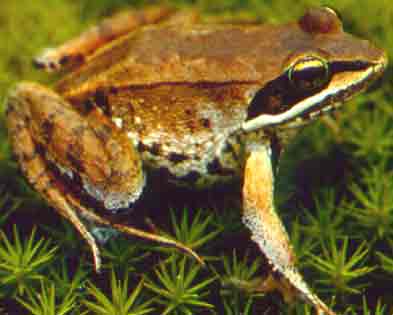
Rana sylvatica
(Wood Frog)
Key Characteristics:
|
Adult Characteristics |
Tadpole Characteristics |
Egg Characteristics |
|
Dark eye mask |
Eyes inset |
Pigmented |
|
Dorsolateral fold |
Long tail |
Small spherical |
|
Light stripe |
Short snout |
. |
|
Webbing not to |
Cream ventrally |
. |
|
Males call |
. | . |
General Description:
Wood Frogs are small to medium sized frogs reaching sizes of around 50mm (2 in.). They vary in coloration, but are generally some shade of brown, green or gray. Wood Frogs have a white ventral coloration with dark mottling near the chest and throat. A characteristic marking on Wood Frogs is the dark stripe extending from the nose, through the eye and past the tympanum. This dark stripe is contrasted by a light stripe along the upper lip. Wood Frogs have prominent dorsolateral folds and relatively short hind legs. The hind feet do not have webbing to the ends of the toes. Males will produce a call that has been described as being similar to the quacking of small ducklings (Nussbaum et al. 1983).
Wood Frog tadpoles have a brown or olive color dorsally, and have a light, pinkish-tinged ventral coloration. Tadpoles can reach sizes of around 50mm (2 in.) prior to metamorphosing. Like other Ranid tadpoles, the eyes of Wood Frog tadpoles are set in from the margin of the head. Wood Frog tadpoles have tails that are nearly twice their body length.
Wood Frog eggs are 2mm (1/12 in.) in diameter and they are pigmented. The egg masses are spherical containing up to 3000 per clutch. As with the Columbia Spotted Frog, multiple females may lay eggs at the same location. This species is an explosive breeder, and most breeding activity will occur over just a few days time.
Idaho Distribution:
Wood Frogs are rare in Idaho. They have only been found in the two northernmost counties of Idaho (Nussbaum et al. 1983).
From northern Alaska, east to Labrador, and south to New Jersey, Georgia, and northern Idaho; spotty distribution occurs south in Rocky Mountains to northern Colorado. Disjunct populations exist in Arkansas and Missouri. Only amphibian in North America to occur north of Arctic Circle.
Habitat:
In the western portion of their range, Wood Frogs are generally associated with more open wooded areas or meadows. They breed in permanent water such as ponds or lakes and then return to the surrounding area to forage. These frogs hibernate terrestrially under forest debris and in the soil.
Found in various kinds of forest/woodland habitats, including edges of ponds and streams, willow thickets, and grass/willow/aspen associations.
Diet:
Unstudied in the Northwest, but at other locales, metamorphosed frogs eat various small invertebrates (mostly terrestrial forms). Larvae eat algae, plant tissue, organic debris, and minute water-borne organisms.
Ecology:
Hibernates/aestivates. Scant life history information exists for the Northwest. Inactive during cold season in north and at high elevations. When inactive, hides in humus, leaf litter, under rocks, or in/under logs. Primarily diurnal in northwestern range and in spring at high elevations, although breeding activity may occur at night. Most active in summer in damp conditions. After leaving pond, usually remains in an area less than 100 m across. Aquatic insect and shrew predators are repulsed by wood frog skin secretions. Population status and distribution in Idaho are unknown, but species has not been collected since early 1980's.
Reproduction:
Females lay eggs in winter through early June, depending on range (in Idaho, known to breed early and move to breeding waters before ice is off ponds). Larvae metamorphose in spring or summer, depending on locality. Period from fertilization to emigration from pond averages about 11-16 wk, depending on range. Adults become sexually mature in 2-3 yr.
Conservation:
|
Status: |
Unprotected nongame species |
|
Global Rank: |
G5 |
|
State Rank: |
S4 |
Species description, key characteristics and original work by John Cossel Jr. © 1997
Species ecological information from Groves et al. ©1997.
Original images provided by Charlotte Corkran and Larry West © 1997
Design and Optimization by Ean Harker©1999, 2000.
DAI layout by Stephen Burton, and Mike Legler © 1999.
